wheel size Hyundai Terracan 2007 Owner's Manual
[x] Cancel search | Manufacturer: HYUNDAI, Model Year: 2007, Model line: Terracan, Model: Hyundai Terracan 2007Pages: 291, PDF Size: 12.79 MB
Page 159 of 291
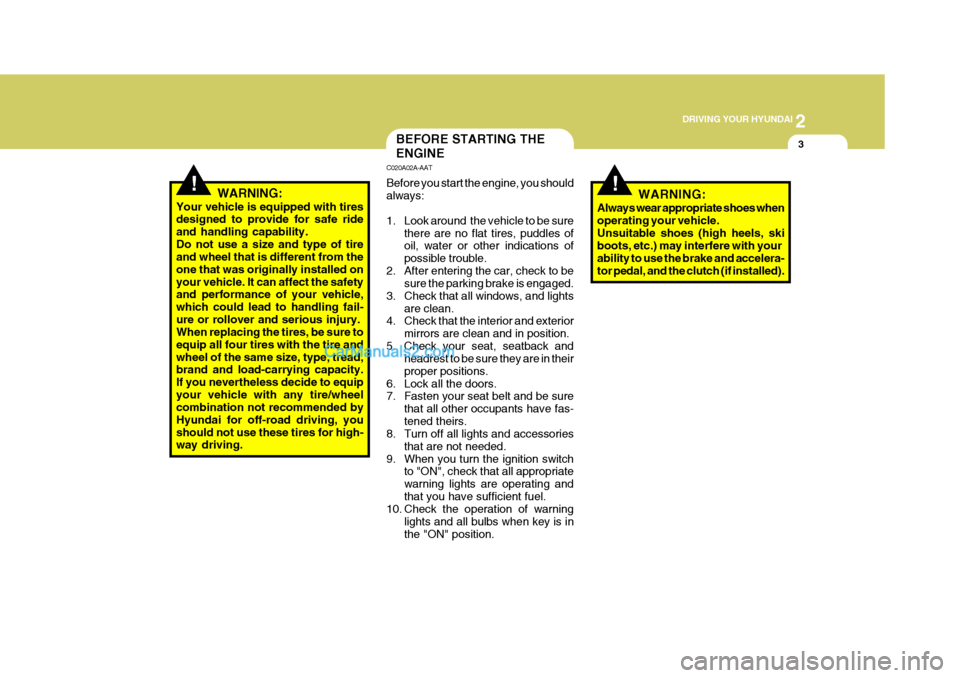
2
DRIVING YOUR HYUNDAI
3
!
BEFORE STARTING THE ENGINE
C020A02A-AAT Before you start the engine, you should always:
1. Look around the vehicle to be sure
there are no flat tires, puddles of oil, water or other indications of possible trouble.
2. After entering the car, check to be sure the parking brake is engaged.
3. Check that all windows, and lights are clean.
4. Check that the interior and exterior
mirrors are clean and in position.
5. Check your seat, seatback and headrest to be sure they are in theirproper positions.
6. Lock all the doors.
7. Fasten your seat belt and be sure
that all other occupants have fas- tened theirs.
8. Turn off all lights and accessories
that are not needed.
9. When you turn the ignition switch to "ON", check that all appropriatewarning lights are operating andthat you have sufficient fuel.
10. Check the operation of warning
lights and all bulbs when key is inthe "ON" position.
WARNING:
Your vehicle is equipped with tires designed to provide for safe ride and handling capability.Do not use a size and type of tire and wheel that is different from the one that was originally installed onyour vehicle. It can affect the safety and performance of your vehicle, which could lead to handling fail-ure or rollover and serious injury. When replacing the tires, be sure to equip all four tires with the tire andwheel of the same size, type, tread, brand and load-carrying capacity. If you nevertheless decide to equipyour vehicle with any tire/wheel combination not recommended by Hyundai for off-road driving, youshould not use these tires for high- way driving.
!WARNING:
Always wear appropriate shoes when operating your vehicle.Unsuitable shoes (high heels, ski boots, etc.) may interfere with your ability to use the brake and accelera-tor pedal, and the clutch (if installed).
Page 174 of 291
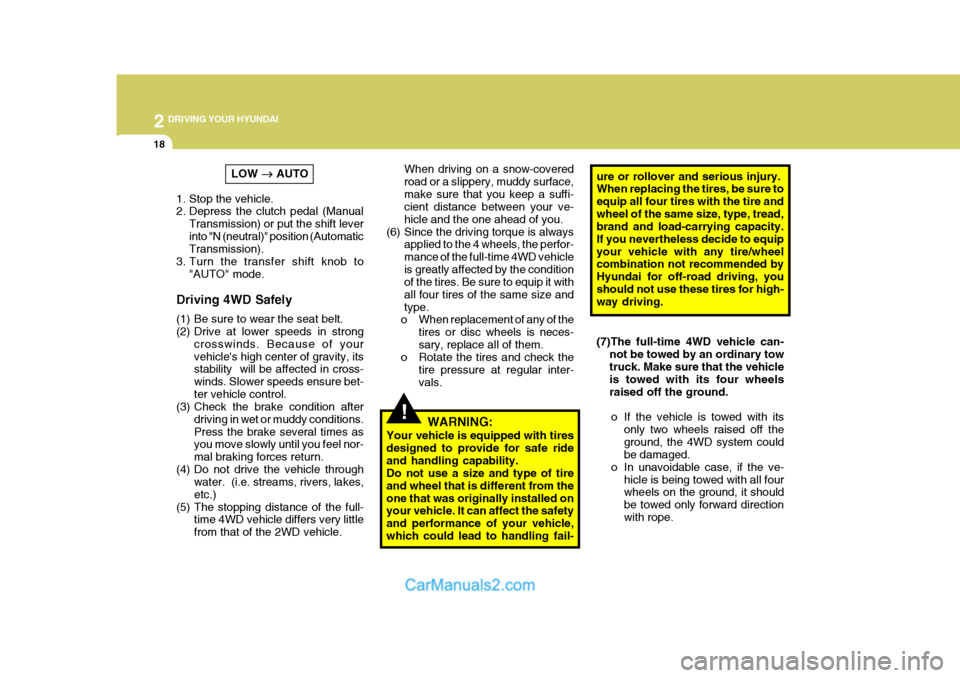
2 DRIVING YOUR HYUNDAI
18
!
When driving on a snow-covered road or a slippery, muddy surface,make sure that you keep a suffi- cient distance between your ve- hicle and the one ahead of you.
(6) Since the driving torque is always applied to the 4 wheels, the perfor-mance of the full-time 4WD vehicleis greatly affected by the condition of the tires. Be sure to equip it with all four tires of the same size andtype.
o When replacement of any of the
tires or disc wheels is neces-sary, replace all of them.
o Rotate the tires and check the
tire pressure at regular inter-vals. (7)The full-time 4WD vehicle can-
not be towed by an ordinary towtruck. Make sure that the vehicle is towed with its four wheels raised off the ground.
o If the vehicle is towed with its only two wheels raised off theground, the 4WD system could be damaged.
o In unavoidable case, if the ve-
hicle is being towed with all fourwheels on the ground, it should be towed only forward directionwith rope.
WARNING:
Your vehicle is equipped with tiresdesigned to provide for safe rideand handling capability. Do not use a size and type of tire and wheel that is different from theone that was originally installed on your vehicle. It can affect the safety and performance of your vehicle,which could lead to handling fail-ure or rollover and serious injury. When replacing the tires, be sure to equip all four tires with the tire andwheel of the same size, type, tread, brand and load-carrying capacity. If you nevertheless decide to equipyour vehicle with any tire/wheel combination not recommended by Hyundai for off-road driving, youshould not use these tires for high- way driving.
LOW
��
��
� AUTO
1. Stop the vehicle.
2. Depress the clutch pedal (Manual Transmission) or put the shift lever into "N (neutral)" position (Automatic Transmission).
3. Turn the transfer shift knob to
"AUTO" mode.
Driving 4WD Safely
(1) Be sure to wear the seat belt.
(2) Drive at lower speeds in strong crosswinds. Because of yourvehicle's high center of gravity, its stability will be affected in cross- winds. Slower speeds ensure bet-ter vehicle control.
(3) Check the brake condition after
driving in wet or muddy conditions.Press the brake several times as you move slowly until you feel nor- mal braking forces return.
(4) Do not drive the vehicle through water. (i.e. streams, rivers, lakes,etc.)
(5) The stopping distance of the full- time 4WD vehicle differs very littlefrom that of the 2WD vehicle.
Page 195 of 291

3
WHAT TO DO IN AN EMERGENCY
7
!
CHANGING A FLAT TIREIF YOU HAVE A FLAT TIRE
D050A01HP-GAT If a tire goes flat while you are driving:
1. Take your foot off the accelerator pedal and let the car slow down while driving straight ahead. Do not apply the brakes immediately or at- tempt to pull off the road as this maycause a loss of control. When the car has slowed to such a speed that it is safe to do so, brake carefullyand pull off the road. Drive off the road as far as possible and park on firm, level ground. If you are on adivided highway, do not park in the median area between the two traffic lanes.
2. When the car is stopped, turn on your emergency hazard flashers,set the parking brake and put thetransmission in "P" (automatic trans- mission) or reverse (manual trans- mission).
3. Have all passengers get out of the car. Be sure they all get out on theside of the car that is away fromtraffic.
4. Change the tire according to the
instructions provided as following. D060A02HP-GAT The procedure described on the fol- lowing pages can be used to rotate tires as well as to change a flat tire.When preparing to change a flat tire, check to be sure the gear selector lever is in "P" (automatic transmission)or reverse gear (manual transmission) and that the parking brake is set, then:
D060A01HPWARNING:
Your vehicle is equipped with tires designed to provide for safe ride and handling capability. Do not use a size and type of tireand wheel that is different from the one that was originally installed on your vehicle. It can affect the safetyand performance of your vehicle, which could lead to handling fail- ure or rollover and serious injury.When replacing the tires, be sure to equip all four tires with the tire and wheel of the same size, type, tread, brand and load-carrying capacity. If you nevertheless decide to equipyour vehicle with any tire/wheel combination not recommended by Hyundai for off-road driving, youshould not use these tires for high- way driving.
Page 275 of 291
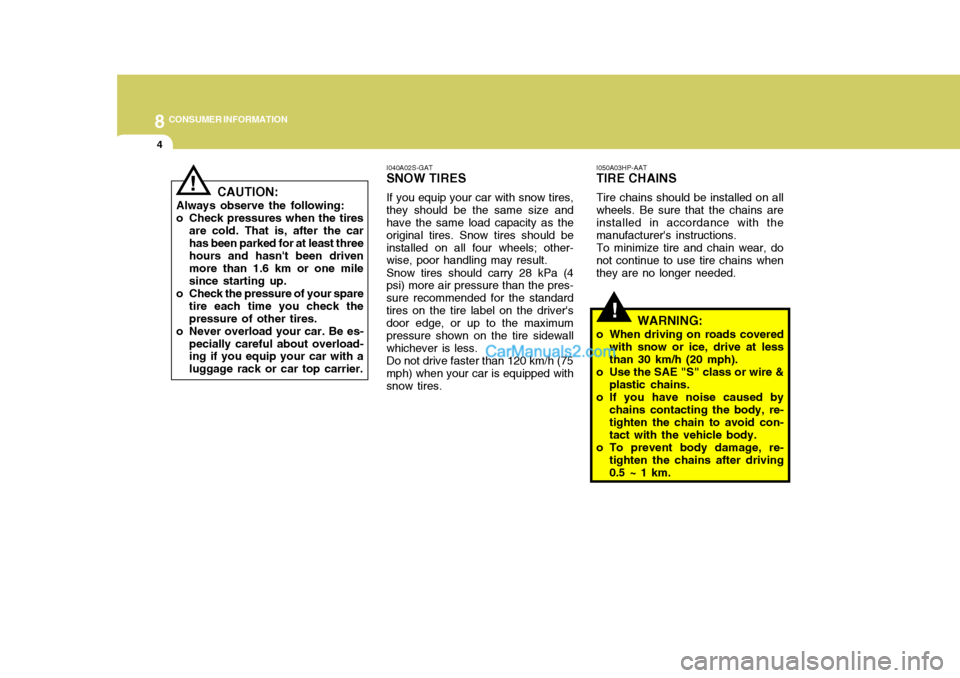
8CONSUMER INFORMATION
4
!
I050A03HP-AAT TIRE CHAINS Tire chains should be installed on all wheels. Be sure that the chains are installed in accordance with the manufacturer's instructions.To minimize tire and chain wear, donot continue to use tire chains whenthey are no longer needed.
WARNING:
o When driving on roads covered with snow or ice, drive at less than 30 km/h (20 mph).
o Use the SAE "S" class or wire & plastic chains.
o If you have noise caused by chains contacting the body, re-tighten the chain to avoid con- tact with the vehicle body.
o To prevent body damage, re- tighten the chains after driving0.5 ~ 1 km.
I040A02S-GAT SNOW TIRES If you equip your car with snow tires, they should be the same size and have the same load capacity as the original tires. Snow tires should beinstalled on all four wheels; other- wise, poor handling may result. Snow tires should carry 28 kPa (4 psi) more air pressure than the pres- sure recommended for the standardtires on the tire label on the driver's door edge, or up to the maximum pressure shown on the tire sidewallwhichever is less.Do not drive faster than 120 km/h (75mph) when your car is equipped withsnow tires.
CAUTION:
Always observe the following:
o Check pressures when the tires are cold. That is, after the carhas been parked for at least three hours and hasn't been driven more than 1.6 km or one milesince starting up.
o Check the pressure of your spare tire each time you check thepressure of other tires.
o Never overload your car. Be es-
pecially careful about overload- ing if you equip your car with a luggage rack or car top carrier.
!
Page 277 of 291
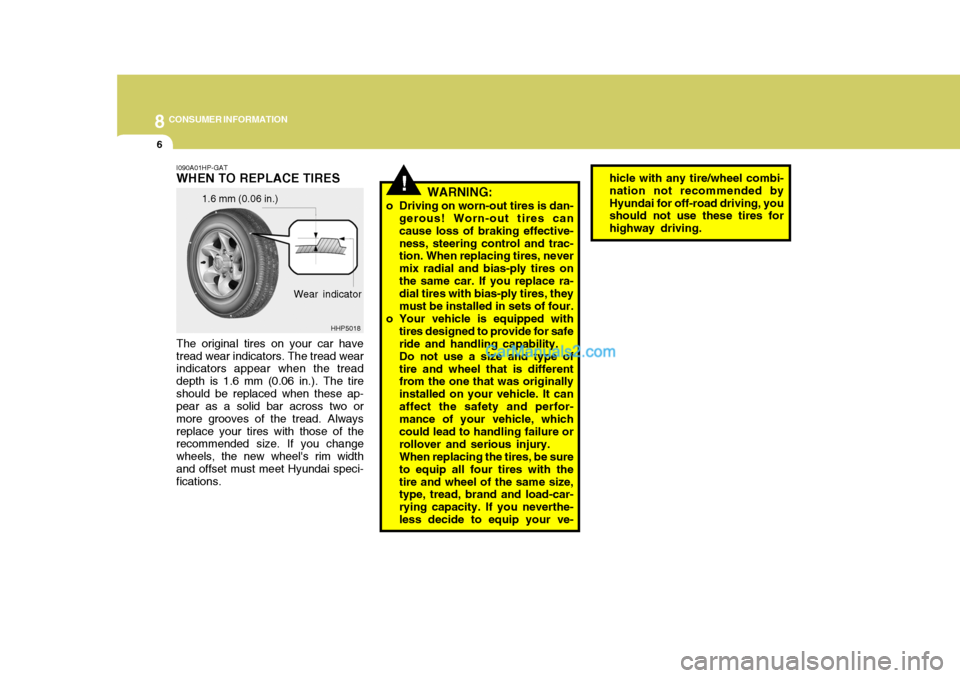
8CONSUMER INFORMATION
6
!WARNING:
o Driving on worn-out tires is dan- gerous! Worn-out tires can cause loss of braking effective-ness, steering control and trac- tion. When replacing tires, never mix radial and bias-ply tires onthe same car. If you replace ra- dial tires with bias-ply tires, they must be installed in sets of four.
o Your vehicle is equipped with tires designed to provide for saferide and handling capability.Do not use a size and type oftire and wheel that is different from the one that was originally installed on your vehicle. It canaffect the safety and perfor- mance of your vehicle, which could lead to handling failure orrollover and serious injury.When replacing the tires, be sureto equip all four tires with thetire and wheel of the same size, type, tread, brand and load-car- rying capacity. If you neverthe-less decide to equip your ve-
I090A01HP-GAT WHEN TO REPLACE TIRES
1.6 mm (0.06 in.)
The original tires on your car have tread wear indicators. The tread wear indicators appear when the tread depth is 1.6 mm (0.06 in.). The tireshould be replaced when these ap- pear as a solid bar across two or more grooves of the tread. Alwaysreplace your tires with those of the recommended size. If you change wheels, the new wheel's rim widthand offset must meet Hyundai speci- fications. Wear indicator
HHP5018 hicle with any tire/wheel combi- nation not recommended byHyundai for off-road driving, you should not use these tires for highway driving.
Page 280 of 291
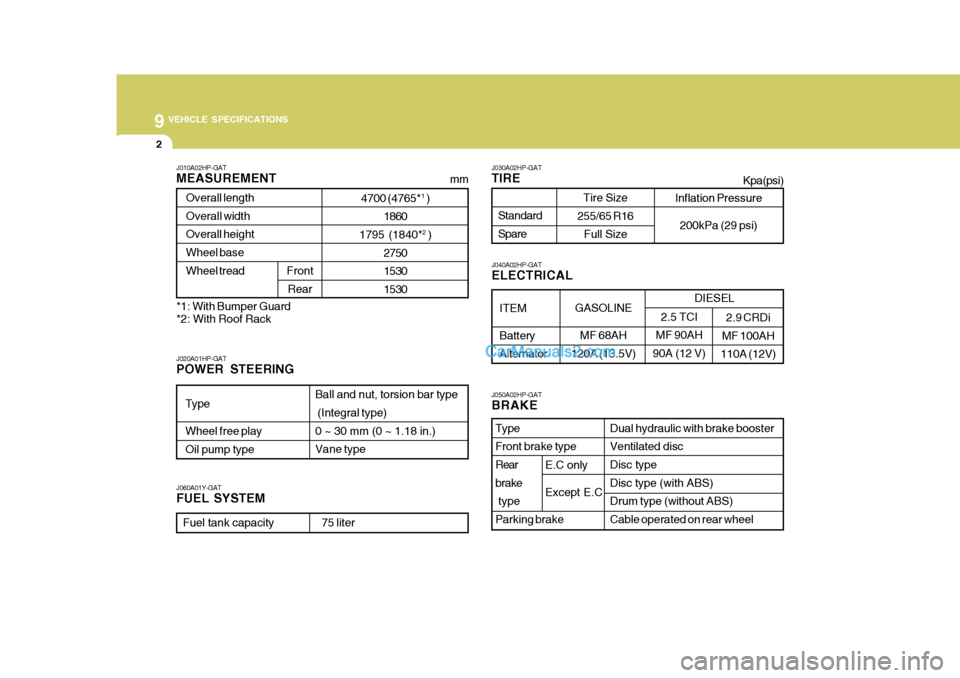
9 VEHICLE SPECIFICATIONS
2
J010A02HP-GAT MEASUREMENT
4700 (4765* 1
)
1860
1795 (1840* 2
)
2750 15301530
Overall length Overall width Overall heightWheel base Wheel tread
Front
Rear
Type Wheel free play Oil pump type Ball and nut, torsion bar type (Integral type) 0 ~ 30 mm (0 ~ 1.18 in.)Vane type
J060A01Y-GAT FUEL SYSTEM
J020A01HP-GAT POWER STEERING J030A02HP-GAT TIRE
Standard Spare
J050A02HP-GAT BRAKE Dual hydraulic with brake booster Ventilated disc Disc type Disc type (with ABS)Drum type (without ABS) Cable operated on rear wheel
Type Front brake type Rear brake type Parking brake
ITEM Battery Alternator
J040A02HP-GAT ELECTRICAL
mm
Fuel tank capacity 75 liter
2.5 TCI
MF 90AH
90A (12 V)
Tire Size
255/65 R16 Full Size Kpa(psi)
2.9 CRDi
MF 100AH
110A (12V)GASOLINE
MF 68AH
120A (13.5V)DIESEL
E.C only Except E.C*1: With Bumper Guard *2: With Roof Rack Inflation Pressure
200kPa (29 psi)